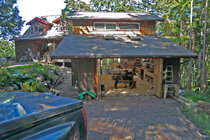apologize for posting this to multiple forums, but I'm not finding much information on my problem. We've recently moved to a semi-remote, small island in the Pacific Northwest. Part of the plan when purchasing our new home was to build a 20 x 24 shop on the property adjacent to the house. Been going through the motions of getting started on construction - there needs to be some significant site prep - retaining wall and fill - to level the site for a post and frame building or stick framing as well. We're locating an engineer to plan and design the site prep. County needs permits for the fill since one corner winds up over 4 feet high. The cost of bringing materials over on the ferry (20 car, open ferry with weight restrictions) starts to ad up.
This weekend we were touring some of the local artist's studios (there's a significant number of artists locally - they hold studio tours on major holidays throughout the year). One studio was in a yurt situated in a somewhat similar situation to my site. It was a pleasant space that seemed to allow for many different configurations. A good conversation with the owner and a little homework online leads me to believe that I can build the platform easily - just a glorified deck, pour a concrete pad for the lathe, and put a 24' yurt on top that will easily withstand both wind and snow loads that we experience locally. Woodstove for heat, double doors both front and back for access, windows all around for light, and fully insulated. And it all fits within budget.
Now the question - anyone turn in a yurt? Know anyone who turns in a yurt? know anyone that has a woodworking shop of any kind in a yurt? Any experience whatsoever with yurts?
This weekend we were touring some of the local artist's studios (there's a significant number of artists locally - they hold studio tours on major holidays throughout the year). One studio was in a yurt situated in a somewhat similar situation to my site. It was a pleasant space that seemed to allow for many different configurations. A good conversation with the owner and a little homework online leads me to believe that I can build the platform easily - just a glorified deck, pour a concrete pad for the lathe, and put a 24' yurt on top that will easily withstand both wind and snow loads that we experience locally. Woodstove for heat, double doors both front and back for access, windows all around for light, and fully insulated. And it all fits within budget.
Now the question - anyone turn in a yurt? Know anyone who turns in a yurt? know anyone that has a woodworking shop of any kind in a yurt? Any experience whatsoever with yurts?



